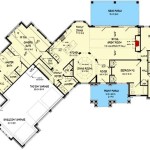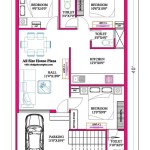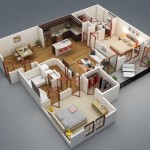Floor Plans for a Small House
Designing a small house requires careful planning and resourcefulness to maximize space and create a functional and welcoming living environment. Floor plans serve as a blueprint for the layout of a house, dictating the arrangement of rooms, flow of traffic, and overall functionality. Here are some considerations and tips for creating optimal floor plans for small houses:
1. Open Floor Plans
Open floor plans eliminate walls between different living areas, such as the kitchen, dining room, and living room, creating a sense of spaciousness and allowing natural light to flow freely throughout the space. By removing unnecessary walls, you can maximize the available square footage and make the house feel larger than it actually is.
2. Multi-Purpose Spaces
Multi-purpose spaces are a great way to optimize space in a small house. For example, a guest bedroom can double as a home office or a playroom can also serve as a guest room when needed. By designing flexible spaces that can be used for multiple purposes, you can cater to different needs without sacrificing space.
3. Vertical Living
Vertical living involves utilizing the vertical space in a house to create additional storage and living areas. Mezzanines, lofts, and built-in shelves are excellent ways to add extra space without extending the footprint of the house. Vertical living also helps to create a sense of height and grandeur, making the house feel more spacious.
4. Smart Storage Solutions
Storage is crucial in small houses. Built-in storage solutions, such as under-bed storage, pull-out drawers, and hidden compartments, can help keep clutter at bay and maximize space. Vertical storage, such as tall bookshelves and wall-mounted cabinets, also helps to save floor space and keep the house organized.
5. Efficient Kitchen Design
The kitchen is often the heart of the home, and in a small house, it's essential to maximize efficiency. Consider using a galley-style kitchen or an L-shaped layout to create a compact and functional workspace. Pull-out drawers, corner pantries, and space-saving appliances can help to optimize storage and make the most of the available space.
6. Maximizing Natural Light
Natural light can make a small house feel larger and more inviting. Incorporate plenty of windows and skylights to allow natural light to flood the space. Use light colors and reflective surfaces to enhance the brightness and make the house feel more spacious.
7. Outdoor Living Spaces
If space permits, consider extending the living area outdoors with a patio, deck, or balcony. Outdoor spaces provide additional room for entertaining, relaxing, or simply enjoying the fresh air. By blurring the boundaries between indoor and outdoor spaces, you can create a more spacious and inviting home.
Remember, designing a floor plan for a small house is not about limiting space but about maximizing it. By incorporating these considerations and tips, you can create a functional, comfortable, and stylish home that feels larger than its actual size.

Best Floor Plan For A Small House Plans One Story

Longshoremans Daughter Small House Floor Plans Tiny

10 Small House Plans With Open Floor Blog Homeplans Com

10 Small House Plans With Open Floor Blog Homeplans Com

27 Adorable Free Tiny House Floor Plans Small

Small House Plans Economical Floor

These Small House Plans Pack A Lot Of Punch Houseplans Blog Com

Small House Plan Examples

Small House Plans Simple Floor Cool

10 More Small Simple And House Plans Blog Eplans Com








